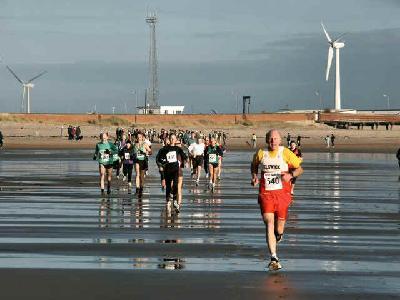|
| af Carsten Staehr, 19-12-2009 |
| Blyth Sands Race 50th anniversary - Great Race and great History |
|
|
The 50th running of the Blyth Sands Race took place Sunday 6th December 2009 and for the first time, I was at the starting line, in the hope, it would kick start my training for Barcelona Marathon in march 2010.
It is one of the many races in North East of England with a great history and quite unusual route.
| 
Blyth Beach |
The event started back in 1959, as it all came about with a challenge from the local rowing club in Blyth who suggested a race between rowers and runners, as long as the rowers received a decent start!
The challenge was accepted and the race was to be run from Blyth Harbour across the bay to Seaton Sluice, around an upright oar, then back, a distance of around five miles.
In the early days the rowers, with county representatives Jim, Tom and Doug Pearson among the keenest, took full advantage of their generous handicap and inevitably crossed the line first, especially those over 40 who were handed a 16-minute start.
Gradually, the race grew and the local Wellesley School got involved to give their students the opportunity to channel their energy in a sporting environment.
However, the rowers no longer take part and the school is now demolished but 50 years on the handicap system first used has been finely tuned, giving athletes of both genders and all ages the chance of winning, though being a handicap there can often be heard a light-hearted gripe or two.
The route varies from day to day and this gives the run a certain novelty. It is not possible to go around the course as it changes by the hour. At low tide the sand is compacted and firm to run on, although the weather can turn this into ripples like corrugated roofing, much worse than the London cobbles. Or when the sea has been particularly wild the surface can be dredged exposing rocks and even the concrete, defensive blocks from the war.
And of course there are the groynes. Groyne strain is a unique injury associated with this event. These piers (four in all) can be a short step-down or a five-foot precipice depending on the severity of the waves. They appear in the first mile, which means they also figure in the last mile. It is possible to minimise the effect of this climb/ drop but that means choosing either a circuitous route away from the shore and treading over the soft sand or going around them at the water line. The water around the groynes however, is of an indeterminate depth. If you are lucky it is up to your ankles, but if not you may find yourself up to your chest in the North Sea. This sudden icy plunging does nothing for ones PBs.
Despite the handicap system which gave me 3 minutes head start, it confirmed that I have a long and hard training schedule ahead of me before Barcelona Marathon. I finished 10th if you turn the results on its head!. It was however a beautiful race in cold but sunny conditions and the Host, Blyth Running Club were perfect. All the runners received a little momentum celebrating the 50th Anniversary of the race and I will definitely be back next year,
|
|